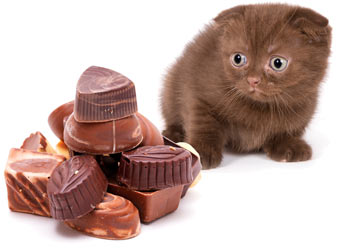Cats and Chocolate: Why Is Chocolate Bad for Cats?

Chocolate is a beloved treat, adored by many. It's around all year but is especially prominent during holidays, including Valentine's Day, Easter, and Christmas. Most people know that chocolate isn't safe for dogs to consume but what about cats?
Chocolate Is Also Toxic to Cats
Cats don't seem to get into chocolate as often as dogs do. They are carnivores by nature, and don't tend to have a sweet tooth. However, there are some cats that would like to nibble on chocolate treats, and it is especially common for kittens to get into it.
Why Is Chocolate Bad for Cats?
Chocolate is high in both fat and sugar. Neither of these substances are metabolized well by cats, and they can cause GI upset, vomiting, and diarrhea, or a more serious illness called pancreatitis. This is an inflammation of the pancreas that results in abdominal pain, lethargy, and anorexia. In cats, pancreatitis may precede fatty liver disease, a very serious, life-threatening liver condition.
Chocolate Contains Caffeine and Theobromine: Both are Toxic to Cats
Beyond the fat and sugar that are irritating to a cat's system, chocolate also contains two substances that are truly toxic to them; caffeine and theobromine. These substances are both part of the methylxanthine family of chemicals. They stimulate the cardiac and neurologic systems in the cat. Therefore, theobromine and caffeine toxicity lead to:
- Vomiting
- Diarrhea
- Increased heart rate progressing to a dangerous abnormal heart rhythm
- Increased temperature
- Seizures
- Coma
- Death
Is All Chocolate Equally Toxic to Cats?
Different chocolate items contain varying amounts of actual cocoa, and this affects the amount of theobromine contained in these products. Unsweetened baking chocolate contains the highest amount of theobromine, followed by dark chocolate, and then milk chocolate. White chocolate has a negligible amount of theobromine in it, but it often has higher fat and sugar levels.
The lethal dose of chocolate for a cat is based on the cat's body weight, the amount of theobromine in the product that has been eaten, and the amount of the item that was consumed.
Here is an example of the amounts of different types of chocolate (in ounces) that a 10-pound cat would need to consume in order to experience toxic effects (smaller cats and kittens require much smaller amounts to reach toxic levels):
| Milk Chocolate | Dark Chocolate | Baking Chocolate | |
|---|---|---|---|
| Mild Effects | 2 | 0.6 | 0.2 |
| Toxic Dose | 4 | 1.4 | 0.5 |
Treatment of Chocolate Toxicity in Cats
As indicated, a very small amount of some types of chocolate can be toxic to cats. If your cat has eaten any chocolate at all, call your veterinarian immediately. There is no specific antidote to this toxin. It takes several days for theobromine to be excreted from the body, so hospitalization and supportive care may be necessary. Your veterinarian may recommend any or all of the following treatments, depending on how much chocolate has been ingested and the signs of toxicity that your cat is exhibiting:
- Induction of vomiting to remove remaining chocolate from the stomach before it can be absorbed (this can be dangerous in cats; don't attempt it without your veterinarian's recommendation)
- Activated charcoal by mouth to bind and prevent further absorption of theobromine from the gastrointestinal tract
- Intravenous fluids to prevent dehydration, replenish electrolytes, and promote the flushing of the toxin out of the system
- Anti-seizure medication
- Anti-emetics for nausea and vomiting
- Cardiac support for increased or abnormal heart rates if they are present
Call your veterinarian right away if you suspect that your cat has eaten chocolate. If your regular veterinarian is not available, call your local veterinary emergency center or the ASPCA Poison Control Hotline at
You May Also Like These Articles:
Common Plants Poisonous to Cats
How to Keep Your Cat from Chewing on Houseplants




